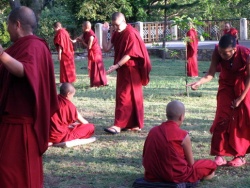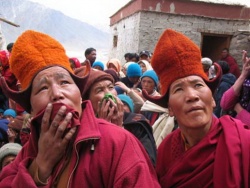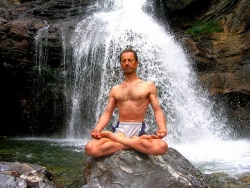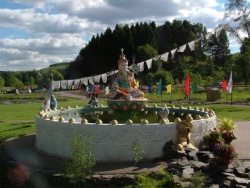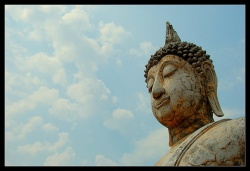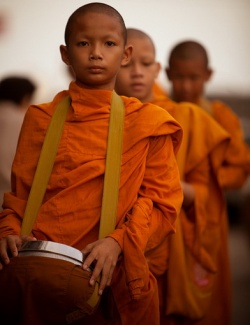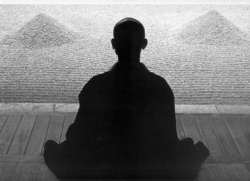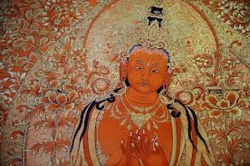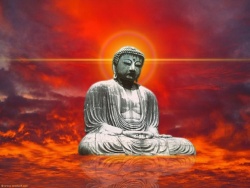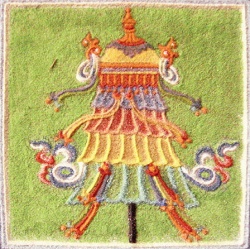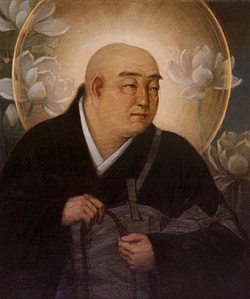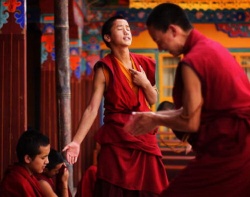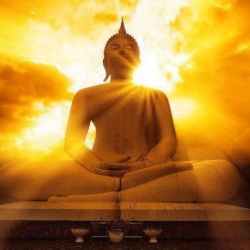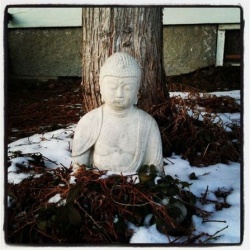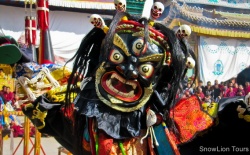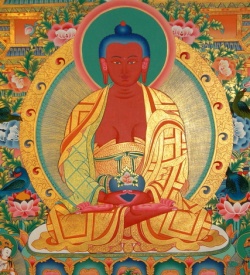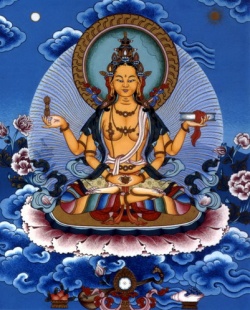Buddhism in the West: Self Realization or Self Indulgence?
by Maria Reis Habito
“I am not religious, but I`m spiritual”. This is a commonly heard statement, especially among younger people, many of whom are disaffected with organized religion, but seek some form of secular spirituality. For many Westerners who would describe themselves in the above way, the teaching of Buddhism holds great attraction. Different from the Abrahamic religions, Buddhism is not based on a revelation by God, but takes its starting point from the enlightenment experience of Shakyamuni Gautama, an Indian prince of the 6th to 5th century BCE, called Buddha, literally “the Awakened One,” by his disciples. Even though the new movement that he founded developed in India and in other regions of Asia as a monastic-based institution, Buddhist teachers coming to the West established practice centers for lay followers rather than monasteries for celibate communities.
The attraction to spirituality, however it is understood and practiced, rather than to an organized form of religion has to be understood from the context of secularization– one of the long-term effects of the enlightenment and modernity. With the advent of modern thinking, and also scientific, technological and economic developments, religions have lost the comprehensive power that they once possessed. Whereas before the enlightenment, religion was used to explain every aspect of life, this of course is no longer the case, except in the most fundamentalist forms of religion that regard modernity as a threat or at least something to be resisted. The violent reactions to the Muhammad-cartoons and the Regensburg speech of the Pope are recent examples of religious attitudes judged by many to be backward, fundamentalist and “unenlightened,” which caught the attention of the media and the world. For most people in the West, religion or religious beliefs are no longer something to fight about. They are often not even deemed a good subject of discussion. In a Western culture, religious choices are regarded to be personal ones, and most certainly not something that should be imposed on others.
What is the Buddhist attitude to religious beliefs, including belief in God? During a recent conference of World Religious leaders in India, an orthodox Rabbi put this question to Ven. Khandro Rimpoche, a world renowned Buddhist teacher, who took the group to visit the sites of Dharamsala, the small town in the foothills of the Himalayas which is the residence of H.H the Dalai Lama and his government in exile. Since visiting Buddhist temples is forbidden to some orthodox Jews for religious reasons, the question was posed to her in a Museum- a place where Buddhist icons are displayed in show-cases but not actually venerated. Ven. Khandro Rimpoche`s answer reflects a genuine Buddhist attitude, one which those who call themselves “spiritual but not religious” might have no difficulty relating to, while it obviously creates a challenge for those who do not espouse a pluralist attitude towards religion. She said: “When I was a small child, I read the story by Dr. Seuss called ‘The Monkey`s Race.’ It goes as follows: a monkey decides to enter a horse-race, but can only find a donkey to ride on. Everybody makes fun of him for his naiveté to believe that he would have a chance in this race. Undeterred, the monkey puts a carrot on a stick and, as the race begins, lets the carrot dangle in front of the donkey’s nose. The donkey, trying to reach the carrot as best he can, runs faster and faster, bypasses all the other horses and wins the race.” We stubborn human beings are just like the donkey,” explained Khandro Rimpoche, “and the religions are like the carrots which make us stubborn beings move. It does not matter what the carrot looks like or what it is called – as long as it makes us move it is useful and fulfills its raison d`être.”
In the following pages I will look at the phenomenon of Buddhism in the West as the spiritual carrot that makes people move, or rather, sit in meditation in increasing numbers. To do so, some background information about basic Buddhist teaching and the development of Buddhism in the West is necessary. For the latter part, I will have to limit myself to the US and Germany. The focus here is on issues that inevitably emerge when a religion is transplanted from one cultural context to another. What happens to a patriarchal tradition in a Western context, which is shaped by democratic ideals, women’s aspirations and their inroads into leadership positions? How is genuine practice affected by a culture that expects instant gratification and quick fixes? What is the relationship between ethnic Buddhists and Western converts? This also touches on one of central questions to be raised here, one that relates to the fundamental Buddhist teaching of No-Self as taken in a Western context, wherein the strong emphasis on individualism and the fulfillment of one’s dreams is diametrically opposed to the Asian notion of community as being more important than the individual. Is Buddhism, as some critics put it, just a “psychospice of self-acceptance” for those who have everything, “some rare ‘inner herb’ of guilt-free self-satisfaction?” And does the use of Buddhist terms disguise the fact that “fundamental Western attitudes about self, society and consciousness have not changed much?”1 Or, more seriously, does the Buddhist carrot, in the words of Slavoj Zizek, turn out to be a “fetish,” which functions as the perfect ideological supplement to capitalist dynamics? The concern is that the commercialization of Buddhism in market and media and its growing popularity as part of the wellness culture threaten to make the dharma into a middle-class commodity that mainly caters to the consumerist drives of the individual needs; and this concern needs to be seriously addressed. Does Buddhist spirituality in the West lead to self-indulgence, rather than self-realization? Or does it open up a new and creative venue, which leads to transformation and, in some cases, even a new appreciation of the religion of one’s childhood? Before turning to these questions, some explanations about basic tenets of Buddhist teaching and development are in order.
1. The Indian and Asian beginnings
The canonical stories paint a very colorful and detailed picture of the life that the future Buddha, young prince Shakyamuni Gautama, led before his quest for enlightenment. Sheltered by his father from any sight that might make him question or abandon his care-free life of luxury, he had not one but three palaces, and was surrounded by beautiful women, entertaining him with music and dances and waiting to fulfill his every wish. Shakyamuni was described as the best wrestler and archer, trained in all the sports and arts of his time. Led by curiosity to leave the palace, he encountered in succession a sick person, and old person and a corpse, which, for the very first time, brought home to him the reality of sickness, old age and death. The last person he encountered on this excursion was a religious renunciant, whose serenity and contentment made Shakyamuni realize that his own life-style, which could be seen as the fulfillment of every modern dream of a good and healthy life, did not give him lasting fulfillment and happiness. And so he left his palace, his wife and young son in the middle of the night to embark on an ascetic path of renunciation in his search for enlightenment. Enduring every kind of hardship and almost starving himself to death, he now saw his former life of physical comfort and mental complacency as the enemy to overcome. However, after six years of extreme austerities, he realized that self-denial did not bring him any closer to understanding and happiness. This is when he decided to take the middle path between self-mortification and self-indulgence, and, not withstanding the criticism of his fellow-ascetics, he bathed, had some food, and then attained enlightenment under the Bodhi tree at the rise of the morning star.
This enlightenment experience, which practitioners of Buddhist meditation strive also to attain, is described as a state of total freedom and perfect peace. It is said that the Buddha remained seated for seven days, rapt in bliss and joy, until compassion eventually moved him to rise from his seat of bliss in order to share his discovery with his companions and others. Tradition holds that, from this point on, the Buddha became the teacher of both devas (divinities) and human beings.
The teaching, called the Dharma, was revolutionary. In the Hindu tradition, dharma referred to the duty of every member of the society to live according to the norms prescribed by the caste system. The birth into one of the four castes was seen as determined by karma – by a fate beyond one’s control, a result created by actions in previous lives. In the Buddhist usage, however, dharma is primarily the liberating truth realized by the Awakened one, and connected to this, the teaching leading to this truth. A teaching such as “I do not call one a brahmana because of one`s origin, or one`s mother. Such is indeed arrogant, and is wealthy: but the poor who is free from attachments, that one I call a brahmana. That one I call indeed a brahmana who is free from anger, dutiful, virtuous, without appetites, who is subdued and has received one`s last body (of birth)…..”2 challenged the religious and political system of Brahamanism, since it ascribed nobility not to birth, but to an ethical way of life and a state of mind perfected by practice. This emphasis on behavior rather than status in the social hierarchy both overturned the fatalistic implications of karma and served to affirm that the worth of a human being depends on one’s actions, not on birth. Today, most Indian Buddhists do in fact come from the bottom rank of society, from the caste of the Untouchables.
In the discourse that is traditionally regarded as the first after his enlightenment, the Buddha, based on his own recent experience, affirmed the importance of the “Middle Way” between the two extremes of sensual indulgence and self-mortification. This was followed by the “Four Noble Truths,” a realistic teaching which holds that life, as most of us experience it, is marked by dukkha, by a sense of dissatisfactoriness, of unfulfilled longing or suffering. The cause of this dissatisfactoriness is craving for finite things – the high-powered job, the house of one`s dreams, the ideal partner, the vacation in the Carribean, etc, etc. From the Buddhist point of view, pursuing these kinds of things does not lead to true self-realization but only results in more craving, and therefore more dissatisfaction. But human beings do not only crave for finite things. On a deeper level, they crave for “existence,” which means the desire to perpetuate ourselves in some form or other in the attempt to negate our own mortality. The opposite side of this is “craving for non-existence,” the sense that the only way out of the constraints of the human condition is by putting an end to it. For example, the high rate of suicide among young people who cannot bear the stress created by our highly technological societies is an indicator for the wide occurrence of this kind of craving.
All these different forms of craving are attributed to a basic ignorance about the way things are, about what we really are. In contrast to the theistic traditions, Buddhism does not hold that there is an individual self or eternal soul (atman), which is created by God and will eventually return to God. Rather, what we call the self, is the coming together of the “five constituents of being” (skandhas), namely bodily form, sensation, perception, mental formation and consciousness. The Buddha clearly declared that no self can be found in any of these, that they come together because of karmic causes and conditions, and that they will disperse again when these conditions no longer pertain. Like everything else in the world, we are marked by impermanence, and like everything else in the world, we are thoroughly interconnected and depend on everybody and everything else for our own existence. In Buddhist teaching, the notion of an independent, individual self is the root of the illusion and suffering because it gives rise to distinction between self and other, and with that to likes and aversions, lust, greed and ill-will and anger. In short, it leads us to behave in ways that create suffering for ourselves and for others, in ways that disregard our deep interconnectedness. It is therefore the opposite of true self-realization.
But there is a way to end dukkha, and this way is the Eightfold Noble Path, which consists of a moral and responsible way of life, meditation and insight. The practice of this path transforms ignorance into wisdom and eventually leads to the total liberation or Nirvana, the state which the Buddha experienced in his enlightenment.3
As the Buddha started to attract more and more disciples with his teachings, he founded the monk’s order on the premise that freedom from worldly cares would be the most congenial way of life to practice meditation and insight. The monks were supported by lay-people, who strove to create spiritual merits for themselves and their family members by giving alms to the monks and donations to the monastery. Since in the Indian society of that time, it was unthinkable for women to remain unmarried and live independently, the Buddha at first refused permission to found a nun’s order, but later agreed, even though the nuns order was placed under strict supervision by the monks. Also, the number of precepts the nuns had to observe was much higher than that of the monks.
Even though the teachings of Buddhism went against the Brahmanic value system, the Buddha never called for political action against priests or rulers. On the contrary, he was dependent on the ruler’s support and protection, and on numerous occasions, the rulers sought him out for spiritual, economic and political advice. When Buddhism entered China in the 2nd century CE, it had to adapt to the Confucian way of thinking in order to make an inroad into the culture. The Confucian system was based on strictly hierarchical relationships that were modeled on the workings of the universe. The ruler, the son of heaven, was conceived to be as far above his subjects as the sky over the earth, husbands were in a similar way just as far above their wives, children had to respect and serve their parents, and younger brothers elder brothers. The only relationship considered as equal was that between friends. Disturbances in these relationships were thought to have potentially disastrous consequences for the harmonious functioning of society and of the universe.
Since Buddhism as a celibate monastic tradition went against the Confucian ideal of filial behavior, which involves taking care of one’s parents and producing sons to pass on the family name and carry out the prescribed rituals of ancestor worship, Chinese Buddhists propagated funeral and memorial rites conducted by the monks as the most filial and efficient way of ensuring deceased family members a safe passage to the other world. In this way, they also secured the financial support of their monasteries. At the same time, the notion that lay persons were not only there to support the practice of the monks and nuns but they themselves could also achieve enlightenment in their own right, gained popularity in China with the translation of the Vimalakirti Sutra. Vimalakirti is described as a householder and city elder, whose enlightened way of life does not even exclude visits to the prostitutes of the town and who easily beats even the disciples of the Buddha in dharma combats. And since Buddhism could not have established itself in China without the support of the rulers, it propagated the idea of the emperor as the Chakravartin, literally, the “Turner of the Wheel,” the enlightened universal monarch who spreads the Dharma. This title originally designated the Buddha himself, but was first conferred to the Indian monarch Ashoka, who had adopted Buddhism as state religion in the 3rd Cent. BCE. In this way, Buddhism spread through the patronage of the rulers, who sponsored the building of monasteries, text translations, and works of art, including the splendid Buddhist rock carvings in places such as Loyang or Yungang.
The two Chinese Buddhist traditions most well-known in the West, traditions that spread with all of their Chinese cultural accompaniments first to Korea and Japan, are Ch`an ( Japanese, Zen) Buddhism and Pure Land Buddhism. Ch`an is the Chinese word for the Sanskrit Dhyana, and means the meditative stages arrived at by Shakyamuni in his search for enlightenment. The beginnings of the Zen tradition are attributed to the legendary coming of the Indian Patriarch Bodhidharma to China in the 5th century, who, after having told the Chinese emperor that his material sponsorship of Buddhism was of no merit whatsoever, went off to sit in a cave facing a wall for the remaining nine years of his life. A four line verse dated from c. 1008 describes Zen:
A special transmission outside of scriptures
Does not rely on words or letter
Pointing directly to the human mind
Sees into one’s nature, becoming Buddha.4
Differently from the Zen-tradition, which emphasizes meditation and individual effort to attain the enlightenment-experience, which, as described above, is direct and intuitive, the Pure Land tradition holds that, ultimately, salvation is only possible through the saving grace of Buddha Amitabha (Japanese, Amida), who comes to guide people from their death-bed to rebirth in the Pure Land. While these two schools are clearly distinguished from each other in both Japan and the West, Chinese Buddhists have always practiced a mixed form, which combines Zen-meditation and study of the Zen texts with chanting of Pure Land texts and prayers.
With this very short overview of the Indian and Asian background, we can now turn to the development of Buddhism in the West.
2) Buddhism in the West
Buddhist source texts became known in Europe only in the 19th.century, but enthusiastic reports about Chinese civilization and religions by the Jesuit missionaries around Matteo Ricci (1552-1610) already inspired enlightenment thinkers such as Gottfried Wilhelm Leibniz (1646-1716) and others, who admired China’s culture of religious tolerance in the wake of the havoc created by the 30 years of war between Catholics and Protestants. Buddhism attracted such influential intellectuals as Schopenhauer, Nietzsche, Wagner and Rhys Davids, as well as the transcendentalists Ralph Waldo Emerson and David Thoreau, who saw in it a welcome alternative to the Christian religion and bourgeois society which they rejected. Herman Hesse`s Siddharta which was published in 1922 influenced at least two generations of readers, and is still on the list of required readings in some high schools in the US.
Even though the development of Buddhism in the West followed different trajectories in different countries, there are certain common characteristics. One of them is the emphasis on an existential and meditative search for new ways of living. Personal guidance of Asian teachers who came to the West supplanted the earlier purely intellectual and academic interest in Buddhism. Also, many young people went to South and South East Asia in the 1960`s in their search for an alternative way of life. Quite a few of them returned well-versed in the languages and scriptures as well as spiritual practices of Buddhism and started to found Buddhist Studies departments in American universities or meditation centers. Even though some of the Western converts to Buddhism profess and practice monastic vows (often temporarily), the vast majority of Western Buddhists are lay people and practice a Westernized from of Buddhism. Differently from lay people in Asian countries, their practice does not center on accumulating spiritual merit by supporting the sangha or donating stupas. They also generally have little interest in the prescribed rituals and ceremonies for deceased family members. Their practice is more akin to that of the monks and nuns, which focuses on meditation and study of the scriptures. However, many Western Buddhists do not necessarily attend a center for meditation and dharma instruction on a regular basis. Many follow the increasing trend of “privatized religion,” which means they follow a spiritual practice independent of any formal allegiance to an institution and do a good portion of their practice at home.
The one major event that helped Buddhism gain a breakthrough in the United States was the 1893 Parliament of World Religions in Chicago, a highly publicized Interfaith event attended by such personalities as the Japanese Zen-Master Shaku Soen (1859-1919) from Japan and Anagarika Dharmapala (1864-1933) from Sri Lanka, who traveled across the US and founded the first Buddhist centers there. One of the greatest popularizers of Buddhism was Shaku Soen`s disciple Suzuki Daisetzu (1870-1966), who was the first to give Westerners a systematic account of the enlightenment experience (Satori) in Zen.
Of course, Asian Buddhists, mainly from Japan and China, had arrived in the US earlier in the 19th century. Most of them settled in California, which was then in the midst of the gold-rush fever. With more liberal immigration laws after World War II, more immigrants arrived, also from Southeast Asian countries and Korea, and brought with them their own Buddhist Temple and community building traditions. But to this day, these ethnic Buddhists on the one hand, and Western converts to Buddhism on the other, still mostly keep to themselves, without much in-depth interaction.
In contrast to Buddhism in Asia that has been largely socially conservative, the “Beat generation” of the sixties, influenced by Suzuki`s writings and those of Alan Watts (1915-1973), discovered Zen Buddhism as an alternative way of thinking. They made it into a life-style that supported their protest against the material culture, the puritanical work ethic and the conformity of the American middle class. Poets such as Alan Ginsberg 1926-1997), Jack Kerouac (1922-1969) and Gary Snyder, like many others, experimented with psychedelic drugs and studied with Buddhist teachers. Their writings express the aesthetic inspiration of every day life, as common in Zen. Arguably the most influential work on Zen Buddhist teachings and practice is The Three Pillars of Zen edited by Philipp Kapleau (1912-2004) which was published in 1965.
With the flight of the Dalai Lama from Chinese-occupied Tibet to exile in India in 1951, Tibetan teachers of different lineages relocated to the West. One of the most important but also most controversial teachers coming to the US in 1970 was Chögyam Trungpa (1939-1987), who founded the Naropa Institute for the Study of Buddhism in 1974 and established a network of Tibetan centers of the Kagyu Tradition. The Theravada tradition is also represented in the US. The “Insight Meditation Center” in Barre, Massachussets was founded in 1976, and students of the resident teachers Joseph Goldstein and Jack Kornfield have brought mindfulness meditation practices into hospitals and therapeutic programs.
In addition to the Japanese Pure Land (Shin) tradition, which was introduced by earlier immigrants, Japanese lay movements such as Soka Gakkai and Rissho Koseikai are also growing rapidly in the US. Membership in these organizations was originally limited to those of Japanese descent, but now they are reaching out to other groups as well and are more popular with African Americans than are other Buddhist denominations.
In Germany, the early stage of translating and discussing Buddhist scriptures, mainly of the Pali tradition, was followed by interest in the practice of meditation, and finally, as in the case of the US, a transformation of Buddhism into a European form. In the early stages, the writings of Arthur Schopenhauer (1788-1860), who saw a similarity between Buddhist teachings on detachment and his own atheistic-pessimist ideas, inspired intellectuals to translate Buddhist texts and even to join Buddhist monks’ orders in Asia. The German Pali-Society was founded in 1909, followed by the Buddhist Community for Germany (Buddhistische Gemeinde für Deutschland), which was co-established by the Physician Karl Seidenstücker (1876-1936) and the Jurist Georg Grimm (1868-1945). Grimm`s major work, The teaching of the Buddha, the Religion of Reason (Die Lehre des Buddho, die Religion der Vernunft) was printed in many editions in 1915. After World War II, numerous groups and centers for Buddhism sprang into existence. The major umbrella organization established in 1989 is called the German Buddhist Union (Deutsche Buddhistische Union).
The emphasis on meditation together with the study of texts was initiated by the writings and teachings of three native Germans who went to Asia and became monks there. Nyanatiloka and Nyanaponika introduced the Theravada tradition, prevalent in South and South-East Asian countries, in more depth. The break-through for Zen-Buddhism in Germany happened with the publication of Zen in the Art of Archery (Zen und die Kunst des Bogenschießens) in 1948. It is considered the most widely read book on Zen in the German language. Lama Anagarika Govinda`s (Ernst Lothar Hoffman, 1898-1985) famous book, Foundations of Tibetan Mysticism (Grundlagen Tibetischer Mystik), published in 1957, laid the foundation for the entry of Tibetan Buddhism into the West. The pioneer who introduced the practice of Zen to Christians in both monasteries and meditation centers, while always remaining a Christian himself, was the Jesuit priest Hugo Makibi Enomiya Lassalle (1898-1990). Zen was further spread by the work of Karlfried Graf Dürckheim (1866-1988) and his center in Todmoos/Rütte. Like Lassalle, Dürckheim was convinced that the development of a meditative form of consciousness was necessary for post-war Europeans to be able to reconnect to their spiritual roots.
As already mentioned above, many Tibetan teachers came to the West after 1959, and founded centers and monasteries there. The monastic “Tibet Institute” in Rikon (Switzerland) was the first, followed by many other centers in Germany and Switzerland. The Theravada tradition was continued by Ayya Khema (1923-1997) who founded the Buddha-Haus in Bavaria.
This short survey of Buddhism in the USA and Germany serves to show that Buddhism has a history that reaches back to the beginnings of the 19th century and even earlier; that it is well established and that it is very diverse.5 At the beginning of the 2nd millennium, the number of Buddhists in the US is an estimated 3 million, the same number as for all of Europe. In Germany it is about 250,000. In some sources, Buddhism is described as the fastest growing religion in the West. With this in mind, we are now ready to turn to the issues that come up when one religion is transferred from one cultural and religious context to another and assumes a popularity that outshines the lure of entrenched traditions. More particularly, we want to look at these issues while keeping in mind the question that was spelled out in the introduction: Is Buddhism a way of self realization or is it self-indulgence? And ultimately, given this question, what is the self we are speaking about?
a) “The Dharma is Neither male nor Female”6
Urged by his aunt Mahaprajapati, who raised him after his mother’s death, the Buddha finally granted permission to establish the nuns’ order, and thereby opened a socially viable option and spiritual path for women, which was an alternative to the traditional role of wife and mother. Canonical texts however contain numerous misogynistic statements about women doubting their ability to become enlightened, including a prediction ascribed to the Buddha to the effect that the life-span of the sangha would decline because of the establishment of the nun’s order. In addition to the earlier Pali sources, texts of the Mahayana tradition, which spread to China, Korea and Japan, also contain the notion that a woman has to be reborn as a man in order to reach enlightenment. In fact, one of the vows of the future Buddha Amitabha of the Pure Land, which is also echoed in other Mahayana texts, is that he will not reach ultimate enlightenment unless all women who desire to give up their female body and acquire a male body will be reborn as men. The Pure Land Sutra maintains that there will be no women in paradise, because all those reborn there will have a male body.
The implications of texts such as these, reflecting the cultural norms and fears of patriarchal societies, have been deep in Asia. Today, women still play a secondary role in Buddhist hierarchies there, with the exception of Taiwan. The fact that the direct monastic line of ordination for women died out in Sri Lanka in the 11th century still affects women in Theravada countries, where the authorities have been resisting the re-installment of full monastic ordination for women. Tibetan nuns have been in a similar situation. So one could pointedly ask what it was that attracted Westerners to a patriarchal religious tradition that in some way considers the male self closer to, or even a precondition of enlightenment? Can only males come to full self-realization?
When Buddhist teachers from Asia started introducing Buddhism to a lay Western audience, these aspects were not highlighted. Women who sought out Buddhist teachers were generally accepted as students, just as men were. In the earlier stages of the introduction of Buddhism to the West, most Westerners did not particularly concern themselves with the position of women in Asian Buddhist countries, and did also not know the texts well enough to draw any conclusions one way or the other. But as Buddhist studies became a discipline in American universities in the 70’s and 80’s, at about the same time when the women’s movement had led to the creation of women’s studies program at universities, these questions came up for scrutiny. Diana Paul’s book Women in Buddhism, published in 1979, systematically explores statements on women in Buddhist sources and addresses the question of how egalitarian tendencies in Buddhism came to terms with the even stronger heritage of misogyny. This was later followed up by Rita Gross’ Buddhism after Patriarchy (1993), which addresses the issue of being a Buddhist Feminist and reading Buddhist texts from a feminist perspective. These and other scholars have pointed out that misogynist statements attributed to Buddha Shakyamuni in fact date from a later period, when the monastic order experienced stress over internal frictions and the rise of the more lay-oriented Mahayana movement. Nevertheless, uneasiness bubbled up among women, since they could no longer be certain that Buddhism was less affected by patriarchal structures than, for example, Judaism and Christianity, traditions that many of them had left behind because of the oppressiveness of their structures vis-à-vis women.
Even though the issue of patriarchal structures in religion, including Buddhism, remains, women in the West (and to a much lesser degree in Asia) have assumed leadership roles in various Buddhist lineages, and this especially in the Zen-tradition where fully authorized women teachers offer spiritual guidance and leadership to their sanghas. This is significant not only in terms of numbers, but also in the qualitative difference that women can make in their teaching. In the West, the question of whether a woman can become enlightened or not is now considered historical, at best. Women have not only carved out their own spaces, both at American universities and Buddhist centers, but have also been in the forefront of helping the efforts of their Asian sisters to gain full monastic ordination and the greater recognition in society that comes with it. Ven. Karma Lekshe Tsomo, an American who was ordained in the Tibetan tradition and currently teaches at the University of San Diego, is the president of Sakyadhita, an international Buddhist women’s organization. One of the organization’s many goals, which also includes the education of Buddhist girls and women in Asia, is to help reestablish the Buddhist nuns’ order where it is not present. As such, the organization invited the Dalai Lama to its conference in Hamburg in summer of 2007, a widely publicized event during which he promised his support for the reestablishment of the Tibetan nuns’ order.
However, the road to the leadership positions that women hold in Buddhism in the West today has not always been smooth. The problem here is not only coming to terms with traditional patriarchal structures and misogynist statements but with the inherent difficulty of having a hierarchical master-disciple relationship, common in traditional Asian societies, transferred to a Western context, and with the ambiguity involved in the very personal relationship between teacher and student, especially when the teacher is a man and the student a woman or vice-versa.
b) “No right no wrong”7
In the Zen and Tibetan traditions, a teacher who has transmission, meaning the full authorization to teach, is seen as a fully enlightened being in historical succession of the Buddha. Thus, the teacher’s behavior is usually beyond question. However, this uncritical attitude has changed after the sexual and financial scandals that troubled some American Buddhist centers in the 70’s and 80’s. On one hand, many students felt attracted to Buddhism precisely because they took as their guiding motto the Buddha’s parting words to his disciples, encouraging them to be a lamp unto themselves, and not to trust any teachers, teachings, or customs unless proven valid through their own experiences. On the other hand, they often accepted a teacher’s behavior without question, believing that the enlightened status somehow exempts the teacher from any objective standard of behavior. A lifestyle involving misappropriation of funds, luxury cars, frequently changing sexual relationships with students and substance abuse would most likely be regarded as self-indulgent or destructive in the case of anyone else, but in the case of an enlightened teacher, these kinds of behaviors were somehow interpreted as an expression of self-realization.8
The herd-mentality that can befall students who gather around a charismatic leader such as, for example, her own teacher, Chögyam Trungpa, was described by Pema Chödrön in an interview conducted by the Buddhist Review Tricycle in 1993. Asked whether it was possible to turn down a sexual invitation by her teacher and still retain a close relationship with him, she answered:
Yes. Definitely. The other students were often the ones who made people feel like they were square and uptight if they didn’t want to sleep with Rinpoche, but Rinpoche’s teaching was to throw out the party line. However, we are always up against human nature. The teacher says something, then everybody does it. There was a time when he smoked cigarettes, and everyone started smoking. Then he stopped and they stopped and it was ridiculous. But we are just people with habitual patterns, and you can count on the fact that students will make everything into a party line, and we did.9
The same edition of Tricycle contains a letter that was composed by Western Dharma teachers after meeting with His Holiness the Dalai Lama to discuss the direction of Buddhism in the West. This letter sets out guidelines for ethical conduct for teachers and encourages students to be very circumspect in choosing a teacher and “to take responsible measures to confront teachers with unethical aspects of their conduct”.10 The issues spelled out in the letter have also been taken up by the annual meetings of Zen-teachers in America, who continue to work on safe-guarding ethical behavior in their own communities. Here is Pema Chödrön’s comment on the letter:
I’m glad to see the subject discussed. It’s important for students to see that dharma teachers have tempers or aggression or passion. Buddhism isn’t about seeing a world all cleaned up or thinking that the world can be all cleaned up. The other side is that it brings up people’s moralism, their conventional mindedness. It concerns me that guidelines like this may become like some government edict or law of the land. My whole training in Buddhism has been that there is no way to tie up all the loose ends. And that comes from my teachers and their teachings. You’re never going to erase the groundlessness. You’re never going to have a neat, sweet little picture with no messiness, no matter how many rules you make.11
This caution needs to be taken seriously. At the same time, for Western Buddhists, who are establishing their own forms of community, be it in centers or in monastic settings where committed sexual relationships are often allowed, the attempt to find rules that guide these new settings are necessary in order to avoid harmful and self-indulgent patterns of behavior. Again, the evaluation of which kind of behaviors are self-indulgent and which ones are not varies and remains in the eyes of the beholder.
c) “Dharma, Diversity and Race”12
The split between white convert Buddhists and ethnic Buddhists, who came from Asia bringing along their own temple traditions, goes back to the beginnings and has not much changed today. And even though the history of Buddhism in Europe is different from that in the US, the split along ethnic lines exists in European countries as well. While the great majority of the early Chinese and Japanese immigrants to the US were followers of the Pure Land School (Jap. Jodo Shinshu), Western students felt attracted by the rigors of Zen-meditation, which promised a quicker path to enlightenment than the chanting of Sutras or the invocation of Buddha Amitabha. In the sixties, the wide-spread use of psychedelic drugs gave many Zen-practitioners a taste of what enlightenment may be like, and they strove to deepen this experience through the practice of meditation. If, by comparison, they walked into a service held by the Jodo Shinshu Sect, they were too much reminded of what they had left behind in their own Jewish or Christian upbringing – the formal services to be attended in ones best clothes, the sermons by the Rabbi or priest on a text of the bible, the singing of hymns and repeating of prayers. Incidentally, immigrant Jodo Shinshu leaders, wanting to adapt to Western cultures, took on forms of religious services from Protestant patterns. In contrast, Zen in the West divested itself of most these community aspects and emphasized instead the individual path to enlightenment.
The sentiments of Asian and Black Americans towards white Buddhists are very complex. Many Asians resent the way in which white Americans have taken “control” or “ownership” of their religion in a way that excludes them from full participation. Black Americans who are engaged in Buddhist practice also express frustration over the fact that they do not have much visibility or voice in American Buddhist culture. They are questioned more than others about the reasons why they have become Buddhists, as if the connection between Buddhism and white practitioners were more normal than their own connection to Buddhism as people of color. At the same time, Asian and black Americans resent the fact that white people are “so attached to their image of themselves as non-racists that they refuse to see their own racism or the way in which Buddhist communities may reflect social hierarchies. This is made more problematic where the emphasis in the predominantly white communities is on letting go of the self.13”
Black Americans have increasingly been attracted to the Japanese lay movements like Soka Gakkai or Rissho Koseikai, which are very community oriented and integrate each member in the so-called “Dharma Discussion Circles,” in which they share personal difficulties or struggles with others and receive advice based on Buddhist teaching. In these lay movements as well as in the more traditional settings of the Pure Land School, being fully part of and involved in a community is considered the most important aspect of Buddhist identity and practice.
It is partly for these reasons that the more individualistic approach of White Western Buddhists, which reflects individualistic cultural norms, draws so much criticism from the others. Victor Sogen Hori, a Japanese Rinzai Zen-practitioner who spent 13 years in full monastic practice in Japan and teaches East Asian Religions at Mc Gill University in Montreal, describes his experiences of participating in a week-long Chinese Ch`an (Zen) retreat, which was attended by both white American and ethnic Chinese. He reports that, when the master asked each participant at the end of the retreat about which benefits he or she had gained from the long hours of sitting in meditation, Westerners uniformly spoke about how it helped them to “get in touch with themselves, given them strength and sanity to cope with the pressures of society, and assisted them in the process of self-realization.”14 The Chinese statements were very different. Chinese participants spoke about how the retreat made them realize their selfishness, their neglect of family and community, and expressed shame and repentance about their shortcomings. When the Master asked the American participants if they had also experienced feelings of repentance, one person replied with a touch of impatience: “You always ask me that and the answer is always no.” Hori concludes that, even though they had spent one week together meditating under the same master, the two groups had experienced the same retreat in very different ways. While the white Americans felt it had strengthened their self-understanding and deepened the process of self-realization, Chinese participants experienced it as moral self-examination.
These differing attitudes arise from culturally different notions of the person: the person as an individual, and the person as a nexus of social relationship. In most societies outside the influence of European enlightenment, the individual is not considered an autonomous being independent of social roles and relations. As the traditional five hierarchical relationships in Chinese culture clearly show, a person has identity only because of his or her particular place in this web of social and family relationships. The Buddhist notion of “No-Self” (Anatta) is deeply connected to the teaching of interconnectedness, which fits well with this concept of a person as a nexus of relationships. It is however far from clear that Buddhist teaching can be made to fit with the Western enlightenment view that the person is an autonomous being. As Hori puts it, “a Buddhist practitioner who has grown up in the West must eventually come to a point of conflict: Do I continue to assert the fundamental autonomy of the self? Or do I accept the Buddhist teaching that the self is created out of interrelatedness? And here is a Buddhist question: are these alternatives mutually exclusive?”15
The different approaches to practice follow from this: while all practitioners have the same need to come to terms with the possessiveness of ego, ethnic Buddhists have a different starting point. They are culturally conditioned to see themselves as part of the whole, as created out of social conditions. The teaching of karma, as well as the traditional respect of hierarchy in family and society, the practices of filial behavior, repentance rituals and ancestral rites; all these are grounded in and at the same time reinforce the assumption that a person is not an autonomous being, but created by social relationships. By comparison, Westerners, even though they feel strongly attracted to the teaching of “No-Self” and interconnectedness, are conditioned to see the person as fundamentally autonomous and individual. Hori`s conclusion about the difference in practice may not be entirely free of stereotyping to make a point, but the challenging observation it contains can not be dismissed easily:
For those who see the person as fundamentally autonomous and individual, Buddhist practice is conceived as freeing the self from incessant social conditioning and releasing its own pure nature; meditation is social deconditioning designed ultimately to affirm and realize the self. But for those who assume that personal identity is created out of social relationship, Buddhist practice is conceived as breaking habits of selfishness in order to become open, responsible, and compassionate with others; meditation is personal reconditioning, designed ultimately to dissolve attachment and de-realize the self.16
From this context it becomes clear that practice taken in the sense of “social deconditioning designed to affirm the self” may not lead to self-criticism or transformation, but on the contrary, that it may well serve to maintain patterns of selfishness, superiority and unacknowledged racism. These are some of the criticisms levelled at white practitioners by angry Asian and African Americans. It may not entirely be the fault of the some Western students that they claim that genuine Zen-practice can only be found in their own particular center, but that it is degenerate in Japan, where monks mainly perform funeral and other services for money. Certain Japanese Zen-masters have been telling this to their Western students, who repeat it uncritically and with conviction. However, to people coming from a non-Western perspective, such claims about Westerners as being the only true practitioners of Zen are taken as a sign of ethnocentrism and self-indulgence, and not of true realization.
While some Buddhist experts, including Hori, warn that the projection of fundamental Western attitudes about self, society and consciousness onto Buddhism ultimately makes it incapable of criticizing Western society, the opposite warning is issued from the philosopher and psychoanalyst Slavoj Zizek, who claims that it is precisely the abandoning of these fundamental Western attitudes which makes Western Buddhists wholly incapable of criticizing the capitalist market system and resisting its temptations (see next section).
d) “Some psycho-spice of self-acceptance”17
While many Buddhists in the West are seriously devoted to their practice, Buddhism has acquired a popularity that reaches far beyond the walls of the meditation hall or temple. It is precisely the fact that Buddhism is able to present itself as a resource not tied to any particular institution, dogma or ritual, which makes it able appeal to the desire for spirituality more than any of the other established religions. While the mix of Buddhism, New Age, Esoteric, Pop-and Wellness Culture since the Nineties contributes to the image of Buddhism as a short-lived, self-indulgent and exotic lifestyle among its critics, it greatly adds to the appeal of Buddhism among many people who look for physical and spiritual well-being. Buddhist symbols are used to market anything, from cosmetics to gardening, interior design to financial planning, and Buddhist ideas appear in medicine, psychology, sports and business. American Buddhist scholar Carl Bielefeld describes this situation in the US as follows:
We seem to be dealing not with a religion, but with something that might be called an ‘American secular spirituality’ – a longing among many (especially the white and upper classes) who are still not satisfied with what they have and who want something more; who have all they can eat but are still searching for that special flavoring, some psycho-spice of self-acceptance, perhaps, some ‘inner herb’ of guilt-free self-satisfaction. This longing for something more, though in most societies very often associated with religion, seems in our society to be associated with a suspicion of religion. We want something more than institutional religion – something more personal, private, more narrowly focused on “me” and how I feel about myself – what I might call I-dolatry.18
It is precisely at this point – Buddhism as “psycho-spice” – that Slavoj Zizek launches his own criticism of Western Buddhism. Zizek sees in the present exchange between Asia and Europe the “ultimate postmodern irony of today.” For him, the irony consists of the fact that, while European technology and capitalism are taking on a world-wide scale, the Judeo-Christian legacy is threatened by New Age “Asiatic thought” ranging from Western Buddhism to different other forms of expression. In this exchange, Buddhism, far from being able to counteract the globalized and highly technologized economy of greed in the West, functions like a fetish, which “enables you to participate in the frantic pace of the capitalist game while sustaining the perception that you are not really in it; that you are well aware of how worthless this spectacle is, and that what really matters to you is the peace of the inner Self to which you know you can always with-draw.”19
With this, we find ourselves in a very interesting situation. On one hand, an Asian Buddhist critic of Western Buddhism, like Victor Hori, says that, as long as Buddhism cannot change basic Judeo-Christian ways of thinking, which emphasize the autonomy of the individual person over the community, it will remain incapable of criticizing Western society. On the other hand, a European critic of Western Buddhism says that giving up the Judeo-Christian spiritual heritage in exchange for Buddhist ideas makes Westerners incapable of criticizing society, since Buddhism functions as the perfect ideological supplement to capitalist dynamics.
Zizek`s criticism, which appeared in a major German Newspaper in October 2000 under the title of “Westlicher Buddhismus? – Nein Danke (Western Buddhism? No, Thank-you) was taken up by Franz Johannes Litsch in the 50 year anniversary edition of the German Buddhist Magazine Buddhismus Aktuell in 2005. Litsch implicitly supports both Hori`s and Zizek`s criticism by saying that many people in the West today are on an inner emigration into Asian culture; that they take over Buddhist ways of thinking without knowing either their own or the other culture well enough. At the same time, they continue to feel, act and think in ways deeply informed by the Jewish-Christian heritage without being aware of their cultural conditioning. He contends that this leads to the creation of “Western Buddhism,” which is based on insufficient knowledge of both cultural backgrounds, and which therefore cannot lead to true self-realization or liberation. While Litsch points out that Zizek does not really know Buddhism or Western Buddhism well, he affirms that Zizek has made an important observation, which should worry everyone who is seriously interested in Buddhist teaching and practice,
because, clearly it was not the goal of the Awakened-One to contribute to this “pursuit of happiness” of everybody, such as it is at the foundation of the American constitution and propagated with missionary zeal all over the world, and as it increasingly becomes the civil religion of Western consumerist societies. Because this is about the unlimited realization of all dreams, wishes, illusions, likes and aversions, which the individual “I” wants to grasp for the confirmation and aggrandizement of its existence. But the Buddha is all about liberation from every kind of grasping for an “I” or for things, and with this, about attainment of a kind of happiness that is not tied to anything.20
So does Buddhism in the West turn out to be some sort of psycho-spice or fetish; is it a carrot that makes the donkey move in the wrong direction – back to the start, rather than to the finishing line? In other words, does Buddhism make people enclose themselves in a palace of material and spiritual comfort, where they shut themselves away from reality? Do they retreat precisely into the place that the Buddha had left behind on his search for enlightenment?
e) “From the beginning, all beings are Buddha”
This opening line of Hakuin`s Ekaku`s (1686-1769) “Song of Zazen”, which forms part of the list of chants in most Zen-Centers today, expresses the basic enlightenment insight of Buddha Shakyamuni, namely that all beings, without exception, are originally enlightened. Hakuin was a very influential reformer in Japanese Zen Buddhism; all of the Rinzai Zen Masters today trace their lineage back to him; and all students in that tradition apply his teachings to their practice.
When a student who is serious about Zen-practice has his or her first interview with a Rinzai Zen teacher, the teacher normally asks the reason why the student wants to take up this practice. Is it because of curiosity — because of something he or she read, saw or heard about Buddhism? Or is it the wish to improve his or her health? Or is it because he or she wants to attain enlightenment? All of these motivations are accepted as valid. And with this in mind, we may want to return to the issues that have become a major point of criticism of and concern about the development of Buddhism in the West- its commercialization, involvement with the wellness culture and inability to provide a thorough criticism of Self and society.
While the commercialization and popularity of Buddhism concerns many Western and Eastern Buddhists alike, not everybody sees this development as entirely negative. Never before has there been so much information so easily available on Buddhism, and many Buddhists see this as a good thing – because it allows a great number of people to discover and pursue Buddhist teachings in ways not ever possible before. Does the marketing of religious objects and tools for mass consumption dilute the teachings by suggesting that one can buy spirituality instead of practicing it? While many would give a definite “yes” to this question, others think that the aesthetic offerings of Buddhism, such as amulets, statues, Zen-gardens, meditation cushions, mandalas, calligraphy, music, incense etc. etc. can be seen as “skillful means” that draw people to Buddhism.21
The discovery of Buddhist meditation practices by propagators and participants of wellness-culture programs is not altogether surprising. In the broadest sense, wellness culture advocates the cultivation of an individual, healthy lifestyle, which is at the same time supported by and reflected in organizational and community culture. Buddhist teachings aim to restore wholeness on the spiritual as well as physical level of our existence. Buddha Shakyamuni was given such titles as “peerless physician,” “supreme surgeon” or “supreme healer”. In the Theravada Tradition, this refers mainly to his teaching of the Four Noble Truths-in which he diagnoses the illness (dukha or dissatisfactoriness) like a physician, and lastly applies the remedy (the Eightfold Noble Path) as a cure. Texts of the Mahayana and Tibetan traditions contain many medical prescriptions and remedies, which are traced back either to the historical Buddha himself or associated with the celestial “Healing Buddha.” But needless to say, these methods are not as easily accessible as focusing one’s attention on the breath, the main tool in Zen-meditation, or mindfulness practice in the Theravada tradition. In the USA for example, the well-known physician and author Jon Kabat-Zinn has introduced mindfulness meditation into therapeutical programs for people with chronic pain and stress related disorders. The combination of meditation and breathing techniques help patients to cope with pain, stress and illness by using moment to moment awareness.
In Zen-meditation, the full attention to the present moment, also described as “becoming one with the breath” or “being in the here and now” is taught as the method leading to awakening. While the side-benefits, such as greater power of concentration, stress-reduction and improvement of one’s health are taken for granted, they are not the ultimate goal of Buddhist practice. The ultimate goal is to completely break through and let go of the self-centeredness or “I-dolatry”, which prevents people from relating to others in wise and compassionate ways. In Buddhism, self-realization means the realization that there is no self to hold on to, and the compassionate practice that naturally flows out of this realization. This goal is not something that can be achieved in just one sit, or participation in just one retreat, even though those can indeed lead to very fresh insights. In Buddhist understanding however, the practice of compassion is something that has to continue moment for moment, not just during this present life, but during future lives as well. It takes nothing less than this to transform self-indulgence into self-realization, to completely awake to the reality that Buddhism describes in terms such as “groundlessness,” “emptiness” and “No-Self.”
Is this realization possible in the West, even among people from Judeo-Christian cultural backgrounds? The fact that there are so many Asian teachers of the different traditions in the West and that they have given full transmission to Western students would point to an affirmative answer to this question. In fact, the late Yamada Koun Roshi, who was the teacher of Father Hugo Enomiya Lassalle and other priests as well as Catholic nuns and lay Christians who now teach Zen meditation in different parts of the world, felt that the Christian notions of “dying to the Self” and love are a most fertile ground for practice and attainment of realization. And what might contradict Zizek`s assumption that being engaged in Buddhist practice leads to throwing the Judeo-Christian legacy over board is the fact that many disaffected Christians and Jews rediscover and reclaim their spiritual roots through their practice of Buddhist forms of meditation. This would confirm Graf Durkheim`s opinion that a meditative form of consciousness is necessary for Europeans to come back to their spiritual roots.22
In a similar vein, Thich Nhat Hanh (born 1926), one of the initiators of “Engaged Buddhism,” a reform movement which spread through Vietnamese Buddhist monks and Western Peace activists at the time of the Vietnam war, emphasizes that the formation of a Western Buddhism is only possible in dialogue with the spiritual foundations of Europe and America, not by rejecting them. Quite a few of the Buddhist reformers like Thich Nath Hanh had either attended Christian missionary schools, received part of their formation in Western universities or otherwise encountered Judeo-Christian ideas and practices of social reform. Engaged Buddhism has motivated Buddhist monks and nuns to leave behind the walls of their monasteries to go out into the streets and get involved in numerous causes ranging from helping the disadvantaged to engaging in ecological projects. In the West, Buddhist teachers such as for example Bernie Glassmann in New York, and his student Anna Gamma in Zurich, have led their students out of the safety and comfort of the meditation hall to do retreats in the streets among the homeless and to become engaged in peacemaker movements.
. *
In conclusion, this review of Asian and Western approaches to Buddhism suggests that in the Buddhist tradition, it is not enough to focus on overcoming delusion, greed and anger on a purely personal level; these also need to be addressed on social and institutional levels, where they can be promoted by collective selves and can take the institutional forms of delusion, greed and ill-will.23 It may well be that socially engaged Buddhism, both in Asia and in the West, has many answers to offer to the criticism of Buddhism as a fetish or “I-dolatry.” It emphasizes that the suffering created by the notion of an individual, separate ego-self is directly tied to and reflected in the problems of society.
If a path that is “spiritual, but not religious” can lead to overcoming the source of suffering, namely the sense of separation between oneself and the rest of the world, and with that to genuine engagement, compassion and care, it is a way to self-realization. But if, on the other hand, it leads deeper into that place of physical comfort and mental complacency that the Buddha had recognized as an impediment to awakening and left behind, it ultimately misses the goal.
1. See section d.
2Dhammapada, chapter 26.
3Experiencing Buddhism. Ways of Wisdom and Compassion by Ruben L.F. Habito (Maryknoll, N.Y 2005) is a very clear and engaging account of Buddhist teachings and developments. Einführung in den Buddhismus by Michael von Brück (Verlag der Weltreligionen im Insel Verlag, Frankfurt am Main und Leipzig 2007) is the best and most recent introduction in the German language.
4 In Habito, Experiencing Buddhism, p. 110.
5 See Michael v Brueck, op.cit., chap. 12 “Buddhismus im Westen”, p. 483-509 for more detailed information and literary sources on this topic.
6 Rita Gross, Buddhism after Patriarchy. A Feminist History, Analysis, and Reconstruction of Buddhism (Albany: State University of New York Press, 1993), chapter 3: “The Dharma is Neither Male nor Female: A Feminist Analysis of Key Concepts in Buddhism.”
7 Interview with Pema Chödrön, Tricycle. TheBuddhist Review (Fall 1993), pp. 16-21
8 For example, Michael Downing`s Shoes outside the Door. Desire, Devotion and Excess at San Francisoc Zen-Center (Washington 2002) gives an account about the scandals at that Center. Another example would be the “crazy wisdom” of Chögyam Trungpa
9 Tricycle, op.cit. p. 17.
10 Ibid, p. 82
11 Ibid, p. 20
12 Title of special section in Tricycle (Fall 1994)
13 Bell Hooks, “Waking up to Racism”, in Tricycle (Fall 1994), p. 43.
15 Victor Sogen Hori, “Sweet-and-Sour Buddhism,” in Tricycle (fall 1994), p. 48-52.
16 Ibid., p. 49.
17 Carl Bielefeld, “Tensions in American Buddhism”, In Religion and Ethics Newsweekly (July 6, 2001), p. 2 (online).
8 See above.
19Slavoj Zizek, “From Western Marxism to Western Buddhism” in Cabinet Magazine (Issue 2, Spring 2001), p. 1 and 3. (online)
20Franz-Johannes Litsch, “Westlicher Buddhismus-Nein danke? Buddhismus und die Kultur des Westens “, In Buddhismus aktuell (Feb. 05), S. 50: „Denn es war ganz eindeutig nicht die Zielsetzung des Erwachten, zu jenem ‚pursuit of happiness’ (Jagen nach Glück) jedermanns beizutragen, wie es der amerkikanischen Verfassung zu Grunde liegt, wie es sich als ‚American way of life’ missionarisch heute in aller Welt verbreitet wird und immer stärker zur eigentlichen Zivilreligion der westlichen Konsumgesellschaften wird. Denn hier geht es um die grenzenlose Erfüllung aller Träume, Wünsche, illusionen, Begierden und Abneigungen, nach der das individuelle Ich zur Bestätigung und Erweiterung seiner Existenz greifen möchte. Dem Buddha dagegen geht es um die Befreiung von allem Greifen nach einem Ich oder nach Dingen und damit um das Erlangen eines Glücks, das nicht an irgendetwas gebunden ist.“
21 These issues are discussed in Sumi Loudoun, ed., Blue Jeans Buddha. Voices of Young Buddhists (Somerville, MA: Wisdom Publications, 2001)
22 For example, see Harold Kasimov, John and Linda Keenan, ed., Besides Still Waters: Jews, Christiansand the Way of the Buddha (Wisdom Publications, Boston 2005)
23About socially engaged Buddhism, see Michael v Brueck, op.cit , chapter 11: Neue Synthese: “Engagierter Buddhismus in Asien, Amerika und Europa” as well as the brilliant work by David R. Loy: Money, Sex, War, Karma. Notes for a Buddhist Revolution .(Wisdom Publications, Boston 2008).
